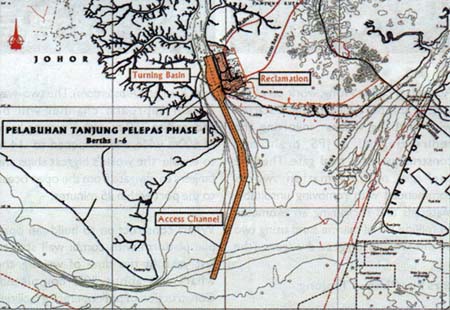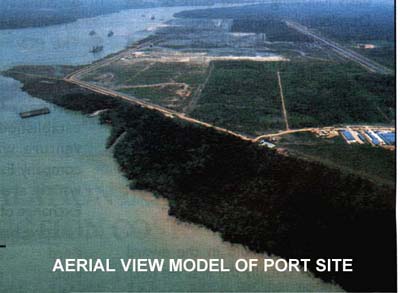
Extract from IEM Magazine April 1999
TANJUNG PELEPAS PORT, JOHOR.
The Tanjung Pelepas Port, situated at the mouth of the River Pulai in south west Johor calls itself the 'container port of the future'. The future being 20 years into the next millennium as this port infrastructure is planned in five phases of development and final completion could stretch to the year 2020. To meet future needs of super large ships, the first phase of the port development has been designed, with 2.16 km linear berths, 115 ha container yards, super large port equipment and sophisticated IT-driven port management.

Tanjung Pelepas Sdn Bhd, a wholly-owned subsidiary of Seaport Terminal (Johore) Sdn Bhd. On March 24 1995, Seaport Terminal entered into a privatisation agreement with the Malaysian Government and the Johor Port Authority to plan, design and construct, operate and maintain the, port, with a concession period of 66 years. The port's strategic location (see diagram 1), along the world shipping route in the Straits of Malacca, offers an attractive alternative to shipping lines which currently call at Singapore. For exporters and importers, access to the port can be via the North-South Expressway, the Senai airport, and a new 5.4 km highway connected to the Second Cossing Expressway.

According to Wong Chut Kun, project director at Pelabuhan Tanjung Pelepas Sdn Bhd, the first two phases of development will cater for container traffic while the third, fourth and fifth phases will have a combination of container, liquid and dry bulk cargo. The entire development, according to its Master Plan, is envisaged to create a new hyper port covering 1,362 hectares of reclaimed land and onshore land.

Construction is presently on-going for the first phase of development. This, in itself, is a huge development for a container port in Malaysia with construction and equipment cost of RM2.8 billion. Spread across a 138 ha site (including the container terminal, port entrance and warehouse), the first phase development will encompass six container berths. Each berth measuring 360 m in length is the most spacious among container ports currently in the country. This will add up to 2,160 m of linear quayside. There will be a sprawling 1.2 million sq. m container yard with a storage capacity of 110,000 TEUs (20-foot equivalent units) and 2,100 reefer points.

Tanjung Pelepas port will be supported by mega large and efficient equipment. Among this are the 18 Super Post Panamax container gantry cranes with an outreach of 53 m, the biggest so far in the country. On the container yard, there will be 58 high-capacity rubber tyred gantry cranes which are six plus one container wide and one over five container high.
According to Mr.Wong, work on phase one of the port development started with enabling works involving the redirecting of a JPS drain and construction of a tidal gate. The first package of reclamation works commenced with removing unsuitable materials and reclaiming an estimated 14 million cubic metres of marine sand using two of the world's biggest dredgers (the
Pearl River and Amsterdam). The two-way, 12 km approach channel will be widened to 250 m with a turning basin of 600m wide, and deepened to 14 m to enable the world's biggest ships and tankers to navigate from the open ocean to the port within 45 minutes.
Wharf construction to build an open pile platform with combi wall started last year. At the time of writing, the wharf was about 30% completed. Construction of port operating facilities comprising the port gate, two office blocks, utilities and drainage facilities, workshops and warehouses and the container yard are currently in progress.

The first two berths are expected to be fully constructed by May this year. Another two will follow by November this year while the remaining two are expected to be completed by February 2000. Contractors are gearing to complete the port facilities by the end of this year, in time for the operation of the first two berths in January 2000.

Click here to check out SSP, the consultant for Infrastructure & Building.